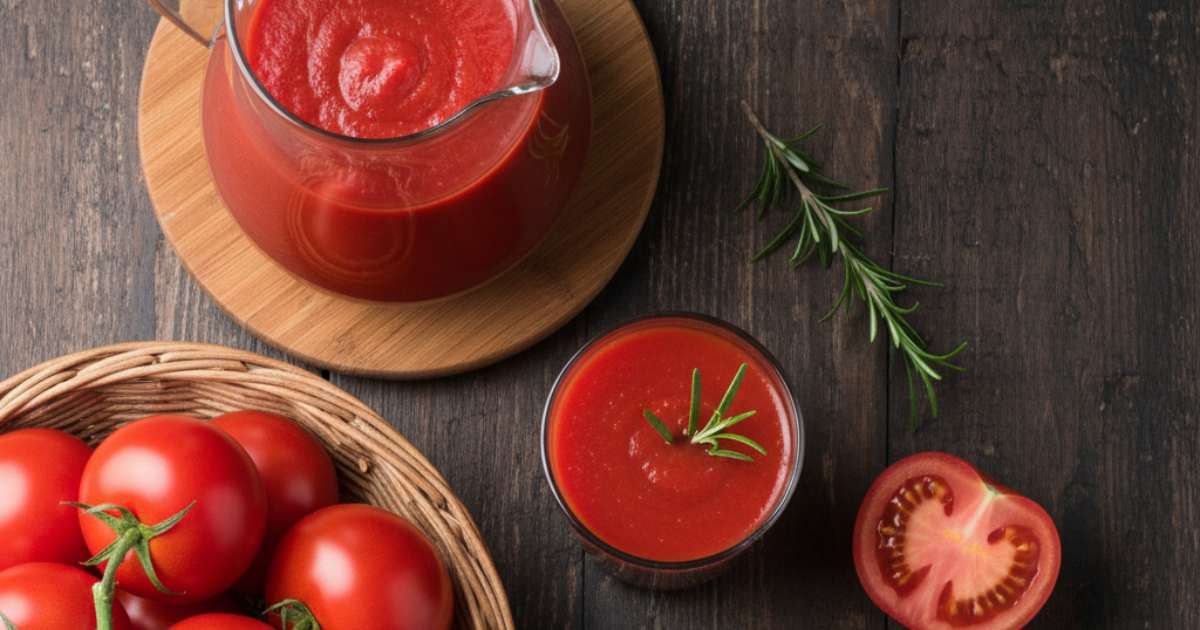Ingredients
Equipment
Method
The 3 Detailed Steps (with why it matters + troubleshooting)
Step 1: Prepare the tomatoes properly (Prep: 10 minutes)
What to do:
- Rinse 2 kg of tomatoes under cold running water, rubbing them gently to remove dirt.
- Remove stems and any bruised spots.
- Quarter the tomatoes and remove large cores if present.
Why this matters:
- peeling tomatoes keeps your puree smooth and bright red.
- Removing cores and bruised parts prevents off tastes and any bitter notes.
- Uniform pieces cook evenly, speeding up Step 2 and reducing the chance of burning.
Troubleshooting tip (during prep):
- If tomatoes are under ripe, they will be tart, wait a day if possible. Overly soft or rotten spots must be cut away.
Step 2: Cook the tomatoes to concentrate flavor (Cook time: 15–25 minutes)
What to do:
- Put the quartered tomatoes into your large pot on medium heat, not add water. Tomatoes release their own juices.
- Stir gently and bring to a gentle simmer. Maintain a steady medium simmer (not a rolling boil) so the tomatoes break down without sticking or burning.
- Cook for about 12-20 minutes until the tomatoes have softened and mostly broken down. Use the wooden spoon to press them gently and release juices.
- Remove from heat and let cool for 10-15 minutes before blending.
Why this matters:
- Gentle simmering concentrates the flavour without caramelizing and becoming bitter. Boiling hard or cooking on very high heat risks a scorched taste and a darker, less appetizing colour.
- Not adding water preserves the tomato intensity and shortens the overall time, water dilutes flavor and increases cooking time
Troubleshooting tips (while cooking):
- If the pot begins to stick, lower the heat and stir more frequently. If it is still hot and sticking, briefly lift the pot off the heat and stir, then return to simmer.
- If the mixture looks very watery after 20 minutes, continue simmering a bit longer, you want most pieces soft and pulpy.
Step 3: Blend, finish, and store (Finish: 10–25 minutes + cooling)
What to do:
- Blend: Transfer cooled tomatoes (in batches if needed) to a blender or use an immersion blender right in the pot. Blend until smooth to your desired texture. For ultra-smooth puree, push the blended puree through a fine-mesh strainer into a clean pot.
- Return & finish cook: Put the blended puree back into the pot on medium-low heat. Add ½ cup (120 ml) oil, 1 tbsp (15 ml) vinegar, 1 tsp (5 ml) sugar, and a pinch of salt (if using). Stir to combine. Simmer gently for 8–15 minutes more, stirring occasionally, until the puree thickens slightly and the oil begins to rise/separate at the edges — that visual cue shows the mixture has reduced and the oil has integrated.
- Cool: Remove from heat and let the pot sit uncovered until the puree is close to room temperature (30–60 minutes for this batch size). Then portion into airtight containers or freezer bags and freeze.
Why this matters:
- Blending after an initial cook preserves color and lets you control texture. Straining removes seeds and bits for a restaurant-smooth finish (optional).
- The second, shorter simmer with oil and vinegar helps round the flavor, stabilizes texture, and gives the puree a glossy, shelf-ready finish. The oil separating slightly at the top is a classic signal that the puree is properly finished.
- Cooling before freezing prevents condensation and ice crystals forming in the container (a basic step so your puree keeps its texture).
Troubleshooting tips (finish):
- If the puree tastes too tart after finishing, a pinch more sugar can balance acidity. Add in small amounts and taste.
- If it’s too thick, don’t add water, fold in a tablespoon of tomato juice saved from the cooking pot, or use a splash of stock when cooking later.
- If it’s too runny, simmer a little longer (low heat) until desired thickness.
Notes
Quick Note on Storage (short & essential)
• Transfer cooled puree into airtight freezer safe containers or freezer bags, portioned to the sizes you’ll use. Freeze flat in bags for space efficiency or in rounded containers.
• Transfer cooled puree into airtight freezer safe containers or freezer bags, portioned to the sizes you’ll use. Freeze flat in bags for space efficiency or in rounded containers.
